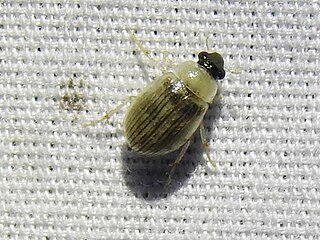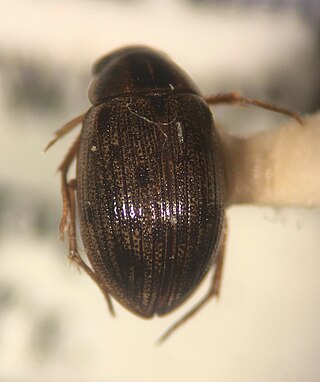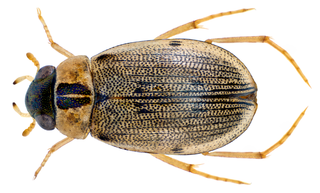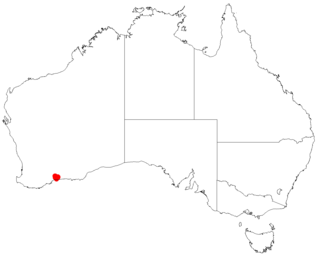
Berosus is a lunar impact crater that is located in the northeast part of the Moon, less than one crater diameter northwest of Hahn. Further to the east-northeast is the large crater Gauss, and to the north-northwest lies Bernoulli. Because of its location, this crater appears foreshortened when viewed from the Earth.

The olive-backed foliage-gleaner is a species of bird in the Furnariinae subfamily of the ovenbird family Furnariidae. It is found in every mainland South American country except Argentina, Chile, Paraguay, and Uruguay.

The chat flycatcher is a small passerine bird in the Old World flycatcher family Muscicapidae that is native to southern Africa.

Berosus is a genus of beetles in the family Hydrophilidae, the water scavenger beetles. The genus contains 273 species. It is distributed worldwide.
Berosus chevrolati is a species of hydrophilid beetles from Cuba.

Berosus exiguus is a species of water scavenger beetles found in the United States, the Bahamas, and Cuba. These beetles are small, ranging from 2.0 to 3.5 mm in length. They can be identified by their small size, yellowish-brown head, distinctly impressed elytral striae (stripes), and often faint spots on the elytra.
Berosus interstitialis is a species of hydrophilid beetles from the Bahamas, Haiti, Guadeloupe, the U.S. Virgin Islands, Puerto Rico and Cuba.

Berosus metalliceps is a species of hydrophilid beetles from the United States, Mexico, the Bahamas and Cuba.

Berosus peregrinus is a species of hydrophilid beetles from Canada, the United States and Cuba.
Berosus quadridens is a species of hydrophilid beetles from Mexico, Guatemala, Nicaragua, Costa Rica and Cuba. It was previously considered a synonym of Berosus truncatipennis.
Berosus trilobus is a species of hydrophilid beetles from the Dominican Republic and Cuba.
Berosus undatus is a species of hydrophilid beetles from the United States, Mexico, the Lesser Antilles and Cuba.

Berosus aculeatus is a species of hydrophilid beetle native to the United States and Cuba. It was originally described by John Lawrence LeConte in 1855 and is characterized by prolonged apices of its elytra.
Ada Ferrer is a Cuban-American historian. She is Julius Silver Professor of History and Latin American Studies at New York University, and will join the faculty at Princeton University as the Dayton-Stockton Professor of History in July of 2024. She was awarded the 2022 Pulitzer Prize in History for her book Cuba: An American History.
Agabus infuscatus is a species of predaceous diving beetle in the family Dytiscidae. It is found in North America and the Palearctic.

Berosus youngi is a species of water scavenger beetle found in the United States.
Phytocoris infuscatus is a species of plant bug in the family Miridae. It is found in North America.

Berosus pulchellus, is a species of water scavenger beetle found in Oriental, Australasian, Afrotropical and Palaearctic regional countries such as India, Sri Lanka, Hong Kong, Japan, Iran, Cambodia and Australia.
Regimbartia is a small genus of beetles belonging to the family Hydrophilidae comprising ten species distributed throughout Africa, South Asia, South East Asia and Australia.

Leucopogon infuscatus is a species of flowering plant in the heath family Ericaceae and is endemic to the south-west of Western Australia. It is a shrublet with many branches, egg-shaped to lance-shaped leaves, and light brown, densely bearded flowers.













